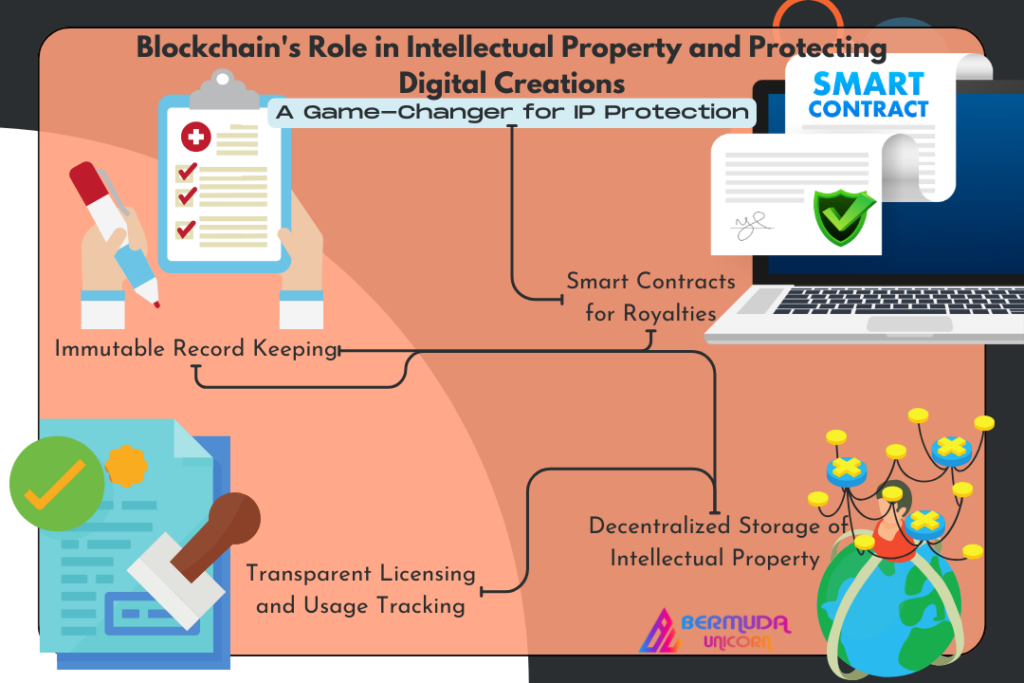![]()

Introduction
In the rapidly evolving digital landscape, intellectual property (IP) creation and distribution have reached unprecedented levels. Artists, musicians, writers, and other content creators now face new challenges in protecting their digital creations from unauthorized use and infringement. In this era of constant connectivity, blockchain technology has emerged as a powerful tool to safeguard intellectual property rights, offering transparency, security, and traceability. Also, in this blog, we will explore the significant role of blockchain in protecting digital creations and reshaping the landscape of intellectual property.
Understanding Intellectual Property
Intellectual property encompasses various creations, including inventions, literary and artistic works, designs, symbols, names, and images used in commerce. In the digital age, the ease of copying and distributing digital content has increased the risk of unauthorized use and piracy. Also, this has led to a growing need for robust mechanisms to protect the rights of creators and ensure fair compensation for their work.
Blockchain Technology: A Game-Changer for IP Protection
Blockchain, the decentralized and distributed ledger technology that underlies cryptocurrencies like Bitcoin, has gained prominence for its potential applications beyond finance. Also, one of its most promising use cases is in the field of intellectual protection of property. Here’s how blockchain can revolutionize the way we safeguard digital creations:

1. Immutable Record Keeping:
Blockchain’s key feature is its immutability. Once information is appended to the blockchain, it becomes immutable and cannot be modified or removed. Also, this property ensures a tamper-proof record of intellectual property ownership and transactions. Artists and creators can register their work on a blockchain, providing a secure and unchangeable proof of creation and ownership.
2. Smart Contracts for Royalties:
Smart contracts, self-executing contracts with the terms of the agreement directly written into code, enable automatic and transparent royalty payments. Also, by embedding royalty agreements into smart contracts, creators can ensure fair compensation whenever their digital creations are used or sold. This eliminates the need for intermediaries and reduces the risk of non-payment or underpayment.
3. Transparent Licensing and Usage Tracking:
Blockchain’s transparent and decentralized nature allows for real-time tracking of intellectual property licenses and usage. Also, every transaction related to the IP, such as licensing agreements or transfers of ownership, is recorded on the blockchain. This transparency reduces disputes and provides a clear audit trail, enhancing trust among creators, distributors, and consumers.
4. Decentralized Storage of Intellectual Property:
Storing digital creations on decentralized and distributed networks, often referred to as decentralized file storage systems, further enhances security. Also, decentralized storage prevents a single point of failure and reduces the risk of unauthorized access or data loss, ensuring the integrity and availability of digital creations.
5. Tokenization of Intellectual Property:
Blockchain enables the tokenization of intellectual property, representing ownership as digital tokens on the blockchain. These tokens can be traded, bought, and sold securely and transparently. Also, this opens up new possibilities for creators to monetize their work directly, bypassing traditional distribution channels.
Conclusion:
Blockchain technology is reshaping the landscape of intellectual property protection, offering solutions to the challenges posed by the digital age. Also, through immutability, transparency, and decentralized mechanisms, blockchain provides a secure foundation for creators to assert and protect their rights. As the digital ecosystem continues to evolve, embracing blockchain in intellectual property can pave the way for a fair, transparent, and efficient future for content creators and consumers alike.
Frequently Asked Questions (FAQs)
1. How does blockchain secure intellectual property?
Blockchain ensures security through immutability. Once data is added, it cannot be altered, creating a tamper-proof record of ownership and transactions for intellectual property.
2. How does blockchain streamline royalty payments?
Smart contracts in blockchain automate royalty agreements. Also, they enforce terms, ensuring creators receive fair compensation for their digital creations without the need for intermediaries.
3. What’s the role of smart contracts in intellectual property?
Smart contracts automate and enforce contractual agreements in intellectual property. They enable creators to embed royalty terms and other conditions directly into the code.
4. How does blockchain enhance transparency in licensing?
Blockchain provides a decentralized ledger for recording all intellectual property transactions. This transparency reduces disputes, offers a clear audit trail, and builds trust among stakeholders.
5. Can blockchain be used for physical intellectual property?
Yes, blockchain can be applied to physical assets, tracking ownership, provenance, and licensing agreements. Its transparency and immutability combat counterfeiting and ensure authenticity.
